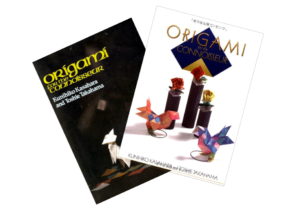Featured image: Washi paper. Tomomarusan, CC BY-SA 3.0, via Wikimedia Commons
Key Takeaways
- Paper Selection Matters: The right paper can significantly impact the success and durability of your origami model.
- GSM Guides Folding: Understanding GSM helps you choose paper with the appropriate thickness for your project’s complexity.
- Explore Beyond Standard Papers: Beyond the standard 15cm x 15cm (or 6in x 6in) origami papers, there’s a large variety of specialized papers—from the popular Washi and Tant to the exquisite Origamido and Unryu—each offering unique textures and properties.
- Proper Paper Preparation: Treating and preparing your paper enhances its foldability and overall performance.
- Access Reliable Resources: Utilize online tutorials, printable guides, and reputable sellers to optimize your origami experience.
When it comes to origami, the type of paper you choose is just as important as the folding techniques themselves. Imagine trying to craft an intricate, delicate model with paper that’s too thick or too brittle—it’s like trying to paint a masterpiece with a worn-out brush. Whether you’re a beginner just learning the basics or an advanced folder creating complex designs, the right paper can make all the difference.
Origami paper isn’t just about pretty colors or patterns; it’s a critical component that can determine the success of your project. With so many options available, from the ubiquitous Kami paper to the luxurious Origamido, choosing the right one can feel overwhelming. Each paper has its own unique characteristics, from thickness and texture to strength and flexibility, making it suited for specific types of models and techniques.
Table of Contents
Understanding Paper GSM and Why It Matters
In the world of origami, paper GSM is one of those technical details that can make a huge difference in your folding experience. GSM, which stands for grams per square meter, measures the weight of the paper. This number tells you how thick or thin the paper is, and it’s a key factor in determining how well the paper will work for different types of origami models.
What is GSM?
GSM essentially tells you how heavy a square meter of the paper is. The higher the GSM, the thicker and heavier the paper will be. For example, standard printer paper typically falls around 80-100 GSM, while newspaper is much thinner, usually around 40-50 GSM. Origami paper, however, covers a broad range of GSMs depending on its intended use.
The GSM affects more than just how the paper feels in your hands. It directly influences the number of layers you can fold without making the model too bulky, how sharp your creases will be, and whether the paper will tear during complex folds. Understanding GSM is crucial for choosing the right paper for your project.
GSM Comparison: Finding the Sweet Spot
Here’s a quick breakdown of how GSM affects different types of popular origami papers:
- Kami (60-63 GSM): Kami is one of the most common types of origami paper. Its GSM makes it light and easy to fold, ideal for beginners and simple models. The lower GSM means it’s thin enough for multiple layers without becoming cumbersome, but it’s also durable enough to withstand repeated folds without tearing.
- Tant (70-80 GSM): Tant paper is slightly thicker, making it stiffer and better suited for intermediate folders. The higher GSM gives it a robust feel, allowing it to hold complex shapes and creases well. However, this increased thickness means it can be more challenging to fold very intricate models that require many layers.
- Washi (50-90 GSM): Washi’s GSM can vary significantly, depending on its type. The traditional Washi paper is typically thinner, around 50 GSM, making it pliable and great for more delicate folds. Thicker Washi papers, closer to 90 GSM, are stronger and can hold their shape well, making them ideal for models that need a bit more structure.
- Foil Paper (50 GSM): With a lower GSM, foil paper is thin and highly flexible, making it perfect for models that require precise, sharp creases. The foil layer adds strength without increasing bulk, but this also means that any mistakes in folding can be difficult to correct, as the creases tend to be permanent.
Choosing the Right GSM for Your Project
When selecting origami paper, it’s important to match the GSM with the complexity of your model and your own experience level. Here are some general guidelines:
- For Beginners: If you’re just starting out, look for papers with a GSM between 50 and 70. Kami paper, for instance, is perfect because it’s thin enough to fold easily but still sturdy enough to handle mistakes. Lower GSM papers are also more forgiving, allowing you to reverse folds without damaging the paper.
- For Intermediate Folders: As you advance, you might find that slightly thicker papers, like Tant or thicker Washi, offer more control over complex shapes. The added stiffness from a higher GSM can help maintain the structure of more intricate models, especially those with multiple layers.
- For Advanced Projects: Experienced folders often use specialty papers like Origamido or Unryu, which may have a low GSM but require careful handling. These papers allow for extremely detailed work but often need to be treated or prepared in advance to prevent tearing.
Common Origami Papers: A Closer Look
Origami paper isn’t just one-size-fits-all. The type of paper you choose can dramatically affect your folding experience, the final look of your model, and even how enjoyable the process is. Let us review some of the most common types of origami paper, and how they can enhance—or challenge—your origami projects.
Kami Paper
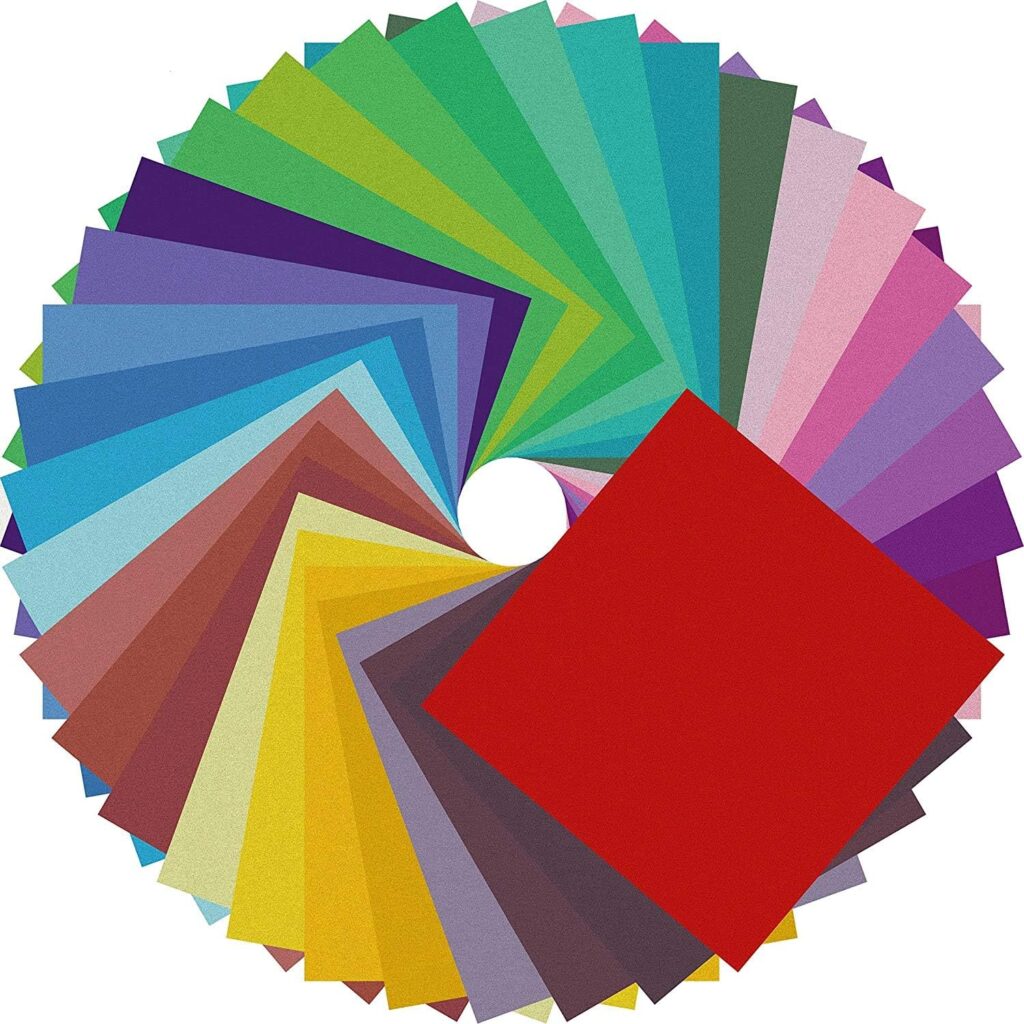
Overview
Kami (standard origami paper) is the go-to for many origami enthusiasts, and for good reason. Originally developed in Japan, Kami—meaning “paper” in Japanese—is the most widely available and recognizable type of origami paper. It’s often the first paper a beginner will use, and it remains a favorite for seasoned folders as well.
Kami typically comes in 15cm x 15cm squares, with one side colored and the other white. This duality makes it easy to create models that highlight contrast or showcase different elements of the design. The paper is thin, smooth, and relatively easy to fold, making it an excellent choice for simple to intermediate models.
Pros and Cons
- Pros: Kami holds creases well, making it easy to achieve sharp, clean folds. It’s also inexpensive, widely available, and comes in a huge variety of colors and patterns, making it ideal for beginners and for practice.
- Cons: The thinness of Kami paper means it’s not as durable as some other types, especially for complex models with multiple layers. It can tear if overhandled, and the white backing can sometimes show through, which might not be desirable for certain designs.
Best Uses
Kami is perfect for simple models, modular designs, and everyday practice. It’s also great for teaching, as its ease of use makes it forgiving for beginners. If you’re working on a model that requires sharp creases and doesn’t involve too many layers, Kami is an excellent choice.
Tant Paper
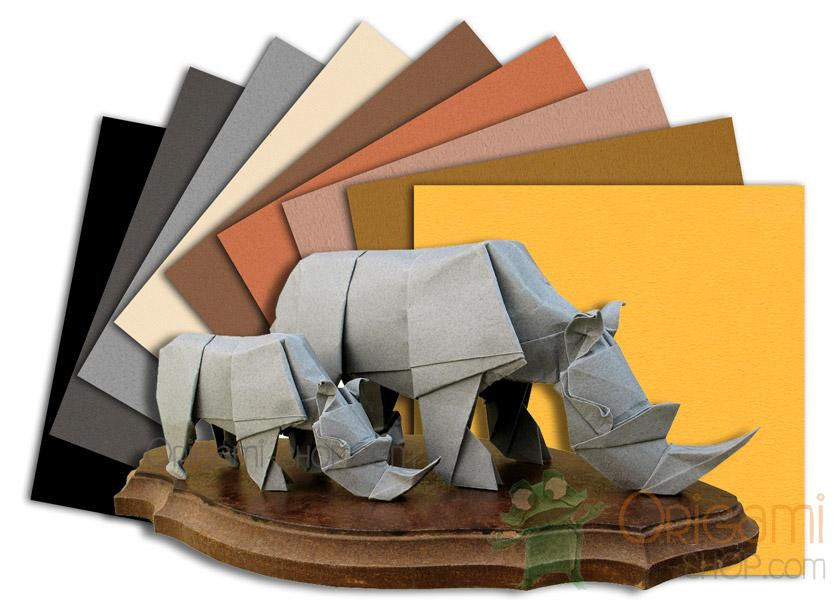
Overview
Tant paper is known for its versatility and vibrant colors. Manufactured in Japan, Tant is a stiffer, textured paper that holds its shape exceptionally well. Unlike Kami, Tant is dyed uniformly, so both sides of the paper have the same rich color, giving your models a consistent look no matter which side is visible.
The paper’s texture adds a tactile element to your work, which can be particularly appealing in display pieces. Its weight, typically between 70 and 80 GSM, makes it slightly thicker than Kami, which gives it added durability without sacrificing flexibility.
Pros and Cons
- Pros: Tant paper’s stiffness and texture allow for precise folds and strong, well-defined shapes. The paper’s uniform color and slight sheen make it ideal for models that will be displayed or photographed. It’s also available in a wide range of colors and sizes, from small squares to large sheets.
- Cons: The added thickness means Tant can be tricky to use for very intricate models with many layers, as it’s more prone to tearing under stress. It also doesn’t come in patterned varieties, which might be a downside if you’re looking for something with a bit more visual flair.
Best Uses
Tant paper shines in both simple and complex models where a strong structure is needed. It’s particularly well-suited for display models, such as flowers, modular designs, and geometric shapes. The paper’s ability to hold its shape makes it a favorite for folders who want their creations to last.
Washi Paper
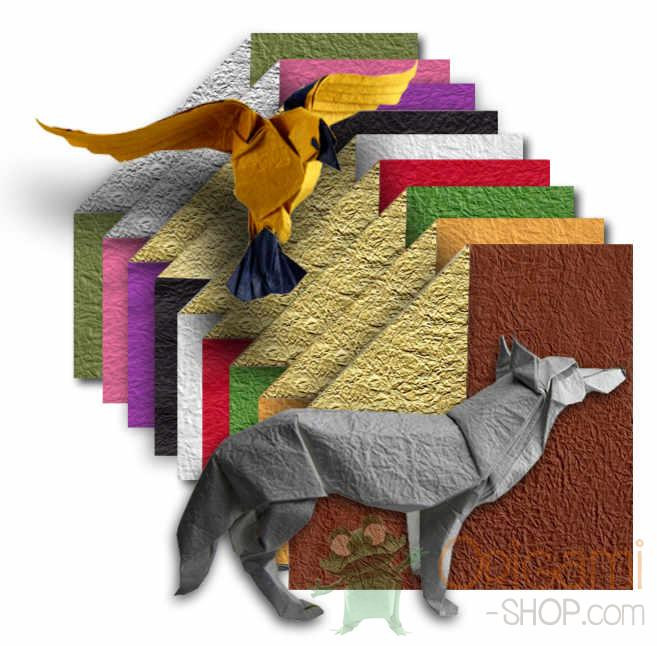
Overview
Washi is a traditional Japanese paper that’s been used for centuries, not just in origami but also in arts and crafts, stationery, and even clothing. Made from long plant fibers, usually from the mulberry tree, Washi is known for its strength, durability, and unique texture. It has a slightly fibrous feel, often described as fabric-like, which gives it a distinctive aesthetic appeal.
Washi paper can vary significantly in thickness, typically ranging from 50 to 90 GSM, and often features traditional Japanese designs, including intricate patterns and even metallic accents. This makes it a favorite for more artistic and expressive origami projects.
Pros and Cons
- Pros: Washi’s strength and durability make it ideal for models that require repeated handling or for wet-folding techniques, where the paper is dampened to achieve smoother curves. Its beautiful textures and patterns add an artistic element to any project, making it a great choice for decorative and display pieces.
- Cons: The thickness and texture that make Washi so appealing can also make it challenging to fold, especially for beginners. It’s more expensive than other common papers, and its fibrous nature can make it difficult to achieve sharp creases or handle very intricate designs.
Best Uses
Washi paper is best used for models that benefit from its texture and durability, such as animals, flowers, and any model where a lifelike or artistic appearance is desired. It’s also excellent for wet-folding techniques and more complex, expressive pieces where the paper’s strength is needed.
Foil Paper
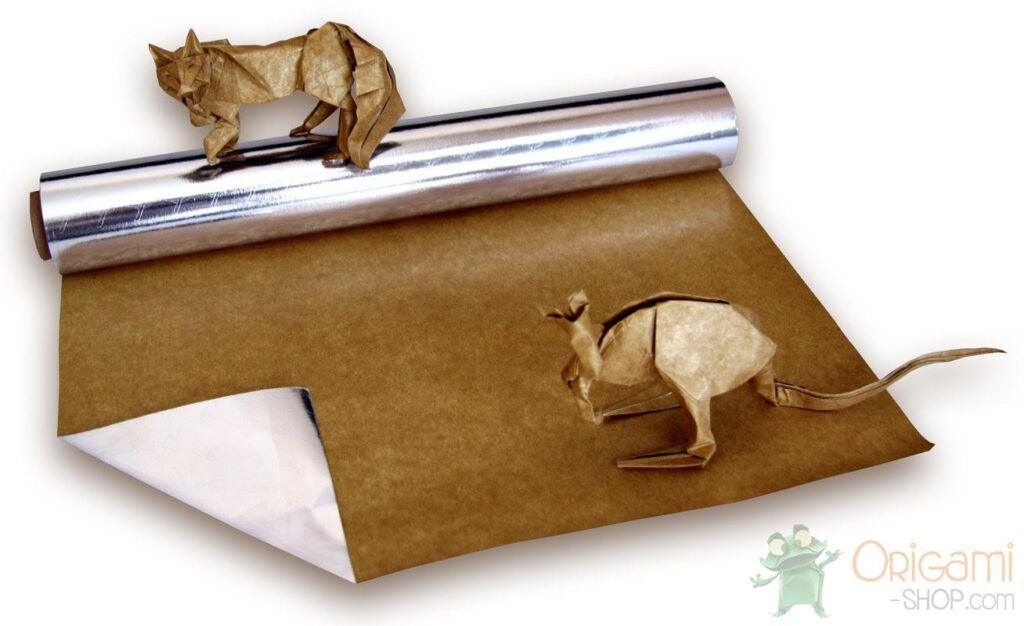
Overview
Foil origami paper stands out for its shiny, metallic appearance and its unique folding properties. This paper typically consists of a thin sheet of foil laminated to a layer of regular paper, creating a material that’s both flexible and strong. The foil gives the paper a reflective surface, which can add a striking effect to your models.
Foil paper is generally thin, around 50 GSM, which makes it easy to fold even into very intricate shapes. However, it’s important to note that once a crease is made in foil paper, it’s there to stay. This permanence can be a blessing or a curse, depending on your folding precision.
Pros and Cons
- Pros: Foil paper is incredibly strong despite its thinness, allowing for sharp creases and detailed folds. Its reflective surface can add a dramatic effect to your models, making them stand out in displays. The paper’s flexibility makes it ideal for complex and intricate designs.
- Cons: The reflective surface can highlight even the smallest imperfections, and mistakes are difficult to undo due to the paper’s unforgiving nature. The foil backing also means that the paper can be prone to tearing if folded repeatedly in the same spot.
Best Uses
Foil paper is perfect for projects that require sharp, precise folds and a striking visual impact, such as stars, insects, and other intricate designs. It’s especially well-suited for models where a metallic look enhances the overall effect. However, it’s best reserved for folders with a bit of experience, as the paper’s unforgiving nature can be challenging for beginners.
Specialty Papers for Advanced Folders
For those who have moved beyond the basics and are ready to tackle more intricate and demanding origami projects, specialty papers offer the perfect medium. These papers are often more expensive and require a bit more skill to use effectively, but they allow for unparalleled precision, durability, and artistic expression.
Origamido Paper
Overview
Origamido paper is often hailed as the gold standard in origami papers, and for good reason. Handmade by origami masters Michael LaFosse and Richard Alexander at their Origamido Studio, each sheet is a work of art in itself. This paper is specifically designed for origami, with a focus on strength, thinness, and foldability, making it ideal for creating complex models that require precision and durability.
The paper is made from a blend of various plant fibers, including Abaca, Hemp, Flax, and others, giving it a unique texture and feel. The GSM typically ranges from 20 to 50, making it one of the thinnest and most flexible options available. Despite its thinness, Origamido paper is incredibly strong, allowing for crisp, clean folds without the risk of tearing.
Pros and Cons
- Pros: Origamido paper is unmatched in quality, providing a smooth, crisp fold that’s perfect for complex models. Its thinness and strength make it ideal for detailed work, and it’s available in a wide range of colors and textures. The paper’s ability to hold creases while remaining flexible is a major advantage for advanced folders.
- Cons: The exclusivity and cost of Origamido paper can be prohibitive. It’s not widely available, often requiring a trip to the Origamido Studio or a special order from select online retailers. This paper is also not for beginners; it requires a delicate touch and experience to fully appreciate and utilize its capabilities.
Best Uses
Origamido paper is best reserved for your most ambitious projects—those that require precision, durability, and a flawless finish. It’s particularly well-suited for complex, multi-layered models, intricate designs, and any project where the quality of the paper will significantly impact the final outcome. Use it when you want to create a masterpiece.
Unryu
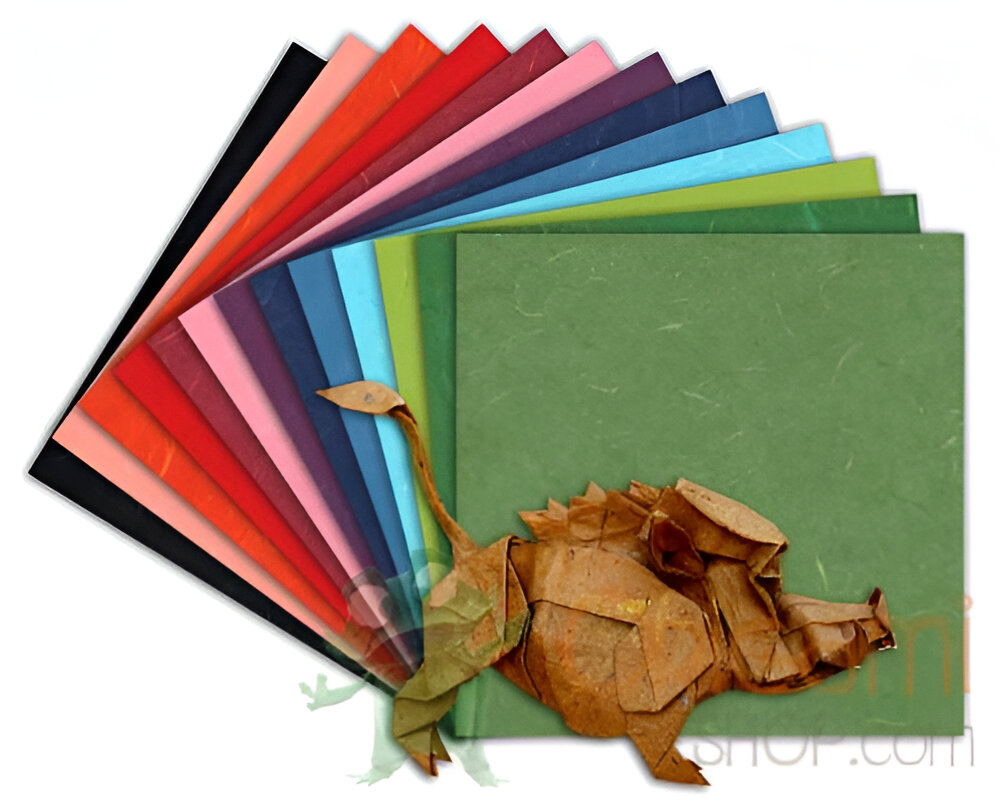
Overview
Unryu is a beautiful and unique option for advanced folders. This handmade paper is crafted from long fibers of mulberry bark, which give it a distinctive, textured appearance. The fibers often run visibly through the paper, creating a striking visual effect that adds depth and character to your models.
With a GSM of around 27, Unryu is exceptionally thin and delicate. However, it’s also strong, thanks to the long fibers that provide reinforcement throughout the sheet. This paper is often translucent, adding an ethereal quality to models, especially when backlit. It’s a favorite among folders who enjoy working with natural, organic textures and want to create models with a soft, flowing appearance.
Pros and Cons
- Pros: Unryu’s unique texture and appearance make it an excellent choice for models that benefit from a natural, organic look. The paper’s thinness allows for intricate folds, and its strength means it can handle complex designs without tearing. The translucent quality adds a special touch, especially in models that play with light and shadow.
- Cons: Due to its thinness and fibrous nature, Unryu requires careful handling and preparation. It often needs to be treated with methylcellulose (MC) or another adhesive to improve its foldability and durability. The paper’s texture can make it challenging to achieve sharp creases, which may not be ideal for all types of models.
Best Uses
Unryu paper is perfect for projects where texture and translucency play a key role, such as flowers, delicate animals, or artistic, abstract designs. It’s also a great choice for wet-folding techniques, where the paper’s fibers can be shaped into smooth, flowing curves. Use Unryu when you want your model to stand out as a work of art with a natural, organic feel.
Elephant Hide
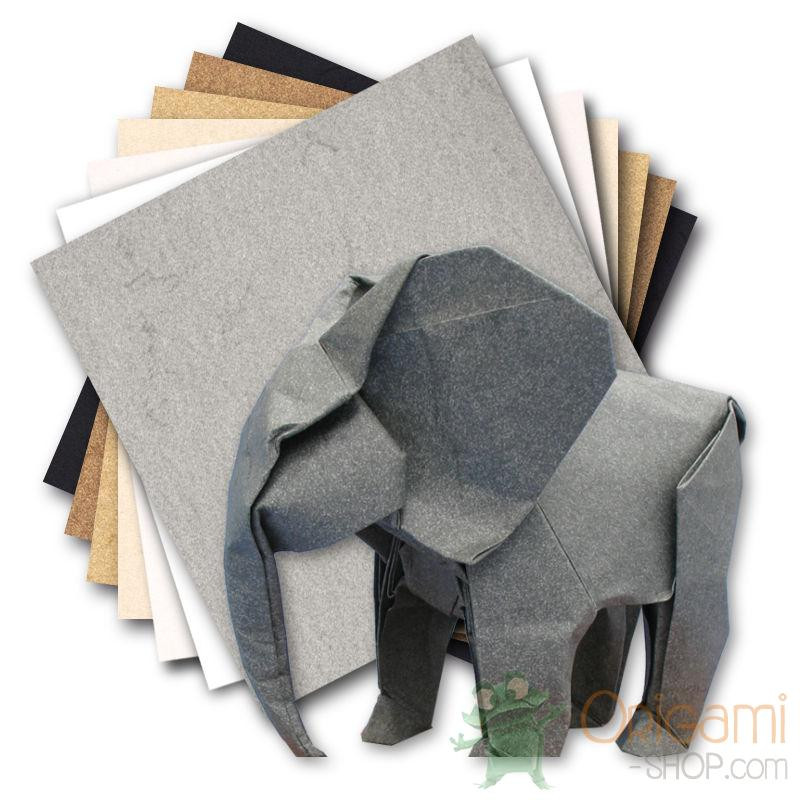
Overview
Elephant Hide paper is a durable and versatile option that’s beloved by advanced origami folders. Despite its name, the paper is not made from elephant skin but is instead a type of high-quality, thick paper originally designed for bookbinding. It’s manufactured by the German company Zanders, which keeps the exact production process a closely guarded secret.
This paper is known for its toughness and ability to hold up under repeated folding and manipulation, making it ideal for models that require a strong, durable medium. With a GSM ranging from 110 to 150, Elephant Hide is thicker than most origami papers, but it remains surprisingly pliable and easy to work with once you get the hang of it.
Pros and Cons
- Pros: Elephant Hide’s durability is its standout feature. The paper can be folded and unfolded multiple times without losing its integrity, making it perfect for complex, intricate models that require a lot of trial and error. It also holds creases well and can be shaped into curves without losing its form, which is great for models that need a sculptural quality.
- Cons: The thickness of Elephant Hide can make it difficult to use for very detailed or layered models, especially for those who are not accustomed to working with heavier papers. It’s also more expensive than standard origami papers, though it’s not as costly as some other specialty papers.
Best Uses
Elephant Hide is ideal for models that require strength and durability, such as architectural designs, tessellations, and geometric shapes. It’s also an excellent choice for wet-folding, where the paper’s thickness and pliability come in handy for creating smooth, rounded forms. This paper is perfect for projects where the model needs to maintain its shape over time, even with frequent handling.
Tissue Foil
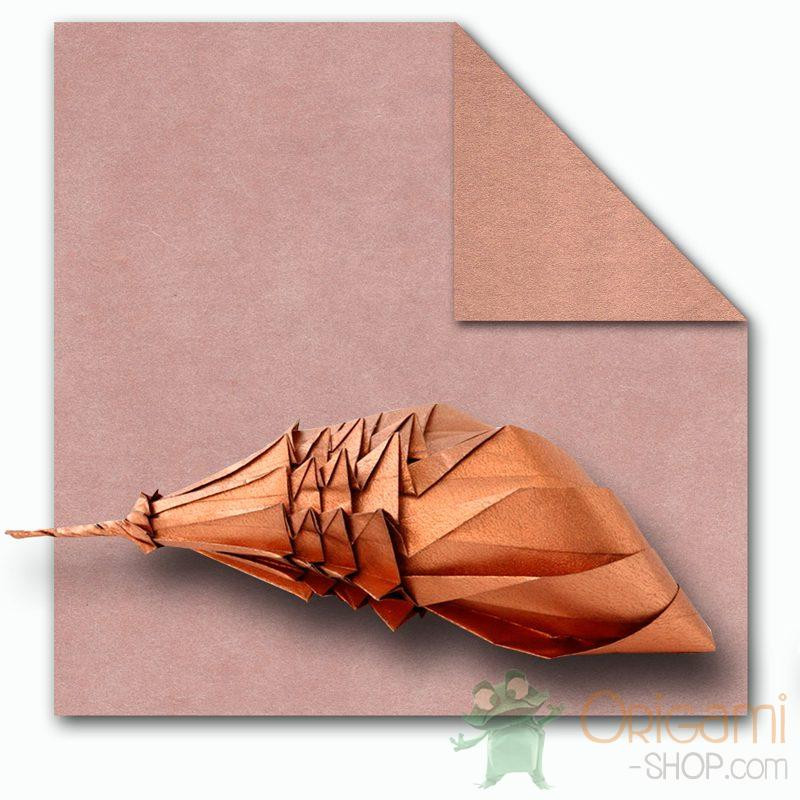
Overview
Tissue Foil paper is a favorite among advanced origami folders for its unique combination of flexibility, strength, and ease of use. As the name suggests, this paper consists of a thin layer of tissue laminated to a sheet of aluminum foil. The result is a paper that’s incredibly thin (usually around 50 GSM) yet strong, allowing for sharp, precise folds and complex shapes.
Tissue Foil’s flexibility makes it ideal for models that require a lot of shaping and sculpting, such as insects, animals, and other organic forms. The foil component helps the paper hold its shape once folded, which is particularly useful for models with intricate details that need to stay in place.
Pros and Cons
- Pros: Tissue Foil is highly malleable, making it easy to fold into intricate designs. The foil layer allows the paper to hold its shape well, even for complex, multi-layered models. It’s also relatively easy to find and comes in a variety of colors, which can add a metallic sheen to your creations.
- Cons: The foil layer can be unforgiving if you make a mistake—once a crease is made, it’s difficult to undo without leaving a mark. Additionally, the paper can be prone to tearing if overworked, especially along sharp folds or if it’s not handled carefully.
Best Uses
Tissue Foil is perfect for models that require precise, detailed folds and a lot of shaping, such as insects, animals, and other organic designs. It’s also a great choice for modular origami, where the paper’s ability to hold its shape is a major advantage. Use Tissue Foil when you want your model to have a striking, metallic finish and need a paper that can handle the complexity of your design.
Lokta Paper
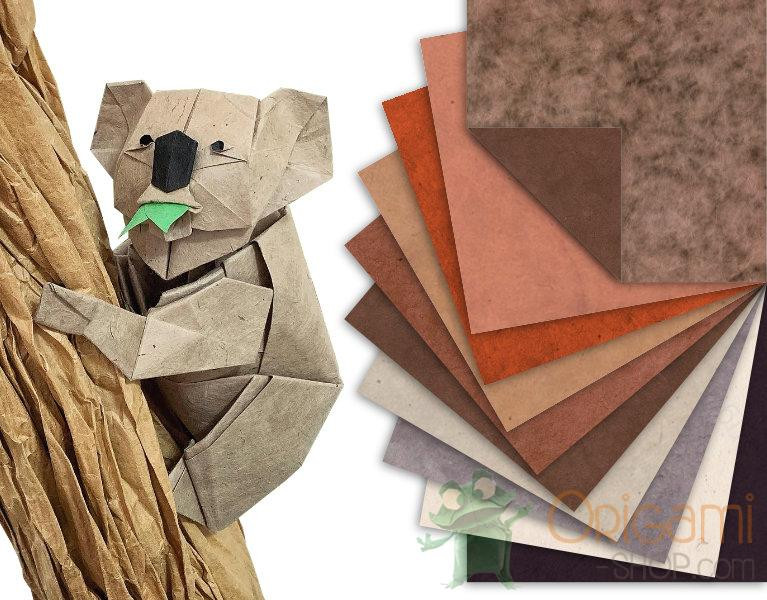
Overview
Lokta paper is a traditional handmade paper from Nepal, crafted from the fibers of the Lokta bush, which grows in the Himalayan forests. This paper is known for its durability, resistance to tearing, and beautiful texture, making it a popular choice for advanced origami folders. It is often used in Nepal for official documents and religious texts, which speaks to its quality and longevity.
With a GSM of around 50, Lokta paper is thin but strong, with a slightly rough, fibrous texture that adds a unique aesthetic to origami models. The paper is available in a range of vibrant colors, and its natural texture makes it particularly well-suited for models that aim to replicate natural forms.
Pros and Cons
- Pros: Lokta paper’s durability and resistance to tearing make it ideal for complex models that require a lot of manipulation. The paper’s natural texture adds a distinct visual and tactile quality to models, enhancing their overall appearance. It’s also environmentally friendly, as the Lokta bush regenerates quickly after harvesting.
- Cons: The fibrous texture of Lokta paper can make it difficult to achieve sharp, precise folds, which may not be ideal for all types of models. Additionally, the paper can be quite expensive, particularly if you’re purchasing large sheets or specialized colors.
Best Uses
Lokta paper is best used for models where texture and durability are important, such as animals, flowers, or other natural forms. It’s also a great choice for projects that will be displayed, as the paper’s vibrant colors and unique texture make for visually striking pieces. Use Lokta when you want to create something that stands out both in appearance and craftsmanship.
Others
Beyond the papers described here, there is a vast array of other origami papers to explore. These include Kraft, Karape, Hanji, Biotope, Glassine, Stark, Rouketsu, Yohishi, Biogami, and many others. Each of these papers brings its own unique properties and aesthetic to your folding projects. For more details and to purchase these specialty papers, check the catalogs available in the online shops listed in section ‘Where to Buy High-Quality Origami Paper‘.
Choosing the Right Paper for Your Project
Selecting the right paper for your origami project is a crucial step that can significantly impact the outcome of your model. The paper you choose should not only match your skill level but also complement the complexity and style of the design you’re working on.
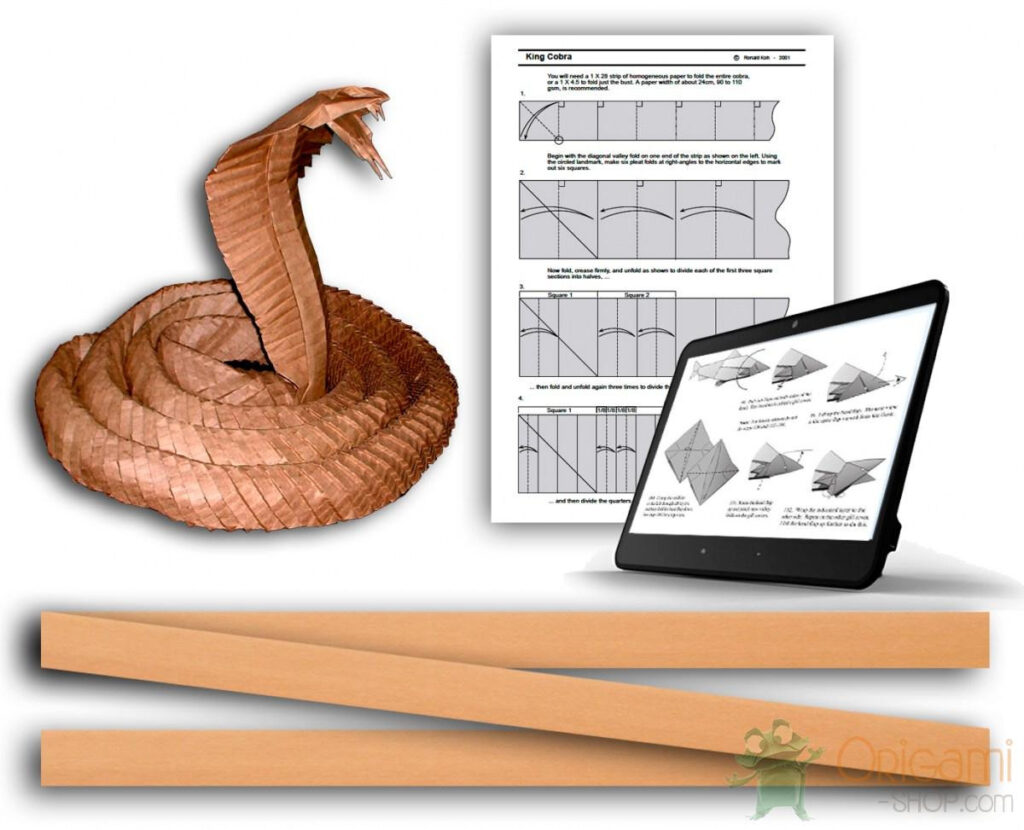
For Beginners: Simplicity and Forgiveness
When you’re just starting out in origami, the paper you choose should be easy to work with, forgiving of mistakes, and affordable enough for lots of practice. The key is to use paper that holds creases well without tearing easily, allowing you to experiment with different folds and techniques.
Recommended Papers
- Kami Paper: Ideal for beginners, Kami is thin, smooth, and available in a wide range of colors. It’s perfect for practicing basic models like cranes, boats, and simple animals. The paper’s affordability and ease of use make it a great choice for those just getting started.
- Duo Kami: This variation of Kami has a different color on each side, which can be helpful for understanding how folds interact in models that require a visual distinction between sides.
- Kraft Paper: Often used for gift wrapping, Kraft paper is an excellent choice for practicing and test folding. It’s strong and durable, holding creases well, and is typically available in large sheets that can be cut down to size. Although it lacks the vibrant colors of Kami, its affordability makes it a practical option for beginners.
Project Examples
- Simple Animals: Start with easy animals like cranes, frogs, or butterflies using Kami or Duo Kami. The paper’s flexibility and ease of handling will help you focus on learning the basics of folding without worrying about tears or creases that won’t hold.
- Modular Designs: Practice assembling basic modular origami, where multiple pieces of paper are folded and then connected to create a larger structure. Kraft paper works well for this because of its strength and durability, allowing you to experiment without using up your more expensive papers.
- Kusudamas: For those interested in decorative balls made from multiple units, Kami paper offers a good balance of flexibility and crease-holding ability, ensuring your kusudamas stay intact.
For Intermediate Folders: Versatility and Durability
As you gain experience, you’ll want to experiment with more complex designs that require papers capable of handling sharper creases, multi-layered folds, and more intricate details. At this stage, you need paper that offers both strength and flexibility, allowing you to create more refined models.
Recommended Papers
- Tant Paper: Known for its versatility, Tant is a great choice for folders who are ready to move on to more challenging projects. Its slightly textured surface and stiffer feel make it ideal for models that need to hold their shape well, such as flowers or geometric designs.
- Washi Paper: Traditional Washi offers a unique combination of strength and flexibility. It’s particularly good for models that benefit from a textured, natural appearance, and it works well with wet-folding techniques, where the paper is dampened to create smooth curves.
- Tissue Foil: If you’re looking to explore more detailed and complex models, Tissue Foil is an excellent choice. Its foil backing provides added strength, making it easier to achieve sharp creases and maintain the shape of intricate designs.
For intermediate models, my personal favorite is Tant paper due to its versatility and vibrant colors. When I’m experimenting with new designs or practicing folds, I prefer Kraft paper for its durability and affordability.
Project Examples
- Flowers and Botanicals: Tant paper’s ability to hold its shape makes it perfect for folding flowers, leaves, and other botanical designs. The paper’s texture also adds a natural feel to your creations.
- More Complex Animals: Move on to more intricate animal designs, such as dragons or complex insects. Tissue Foil’s flexibility allows for precise folds, while its strength ensures that the final model holds up under multiple layers and detailed shaping.
- Geometric Shapes and Modulars: For intermediate modular designs, such as more intricate polyhedra, Tant paper offers the durability needed to keep the pieces together while maintaining a crisp, clean appearance.
For Advanced Projects: Precision and Aesthetic Excellence
Advanced origami projects often involve highly complex designs that require papers with specific properties—such as extreme thinness for precise folds, or a unique texture for a particular aesthetic. At this level, the paper not only supports the structural needs of the model but also enhances its visual impact.
Recommended Papers
- Origamido Paper: Considered the pinnacle of origami papers, Origamido is perfect for creating models that require the utmost precision and detail. Its thin yet strong composition allows for the most intricate folds and designs, making it ideal for professional-level work.
- Unryu Paper: For projects that benefit from a textured, almost ethereal look, Unryu is the paper of choice. Its long fibers and translucent nature add a unique aesthetic to models, especially those that play with light and shadow.
- Elephant Hide: When durability is paramount—such as in tessellations or architectural models—Elephant Hide offers the strength and stability needed. Its thickness and ability to hold up under repeated folds make it an excellent choice for projects that require precision and a sculptural quality.
For complex models, I often use a tissue-foil-tissue ‘sandwich’ paper or a 2-4 layered tissue paper, glued together with MC. I make these multilayered papers myself, which allows for great customization in thickness and texture. However, if you prefer a ready-made option, these types of papers are also available at origami-shop.com.
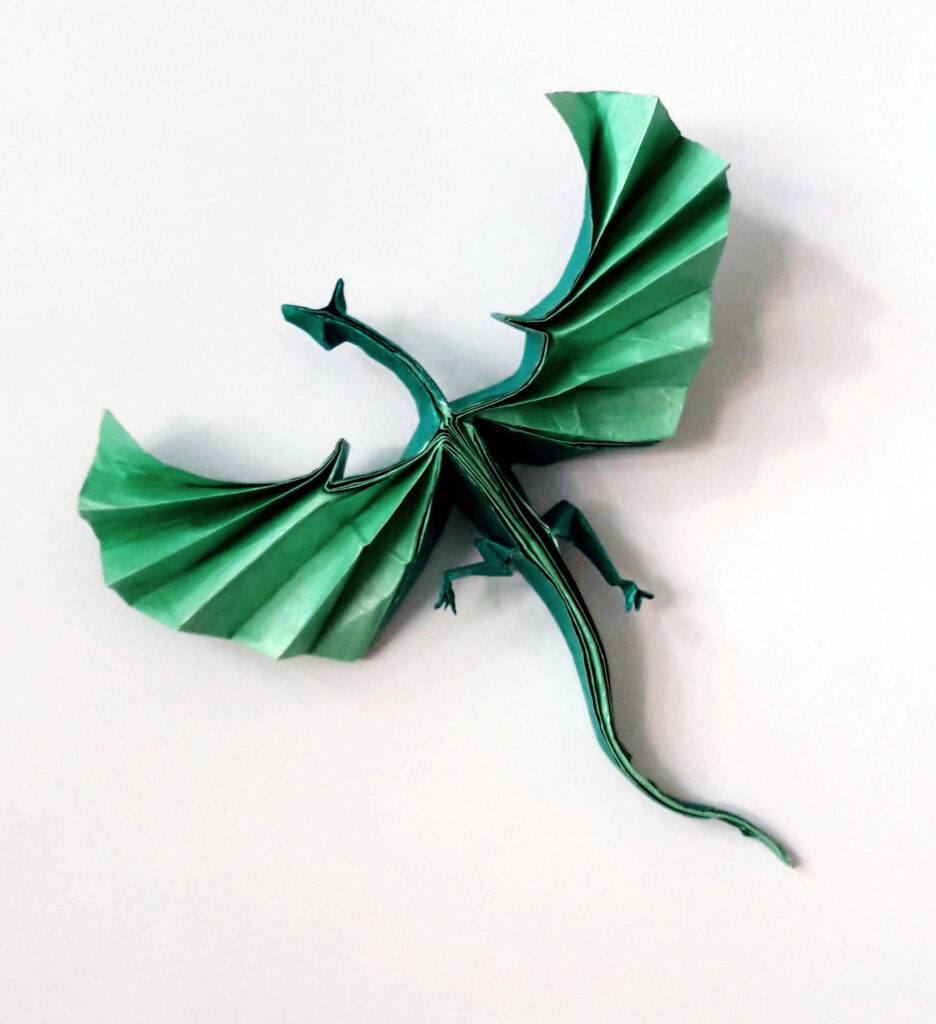
Project Examples
- Super-Complex Insects: For highly detailed insect models with numerous folds and layers, Origamido paper is unmatched. Its strength and precision allow you to achieve fine details that would be difficult with other papers.
- Architectural Designs: Elephant Hide is perfect for creating architectural models, such as tessellations or 3D structures, where the paper’s durability and ability to hold creases are essential.
- Artistic and Abstract Models: Use Unryu paper for artistic or abstract origami, where the paper’s texture and translucency add depth and interest. This paper is ideal for creating pieces that are as much about the material as they are about the form.
Tips for Paper Preparation and Maintenance
Proper preparation and maintenance of your origami paper are essential steps in ensuring that your models not only look their best but also stand the test of time. Whether you’re working with standard papers like Kami or more delicate specialty papers like Unryu, how you handle and treat your paper can significantly impact the quality of your folds and the durability of your finished model.
Paper Treatment Techniques
Many advanced origami papers, especially those that are thin or fibrous, benefit from treatment before they are folded. Treating the paper helps it hold creases better, reduces the risk of tearing, and can enhance its overall appearance. Here are some common techniques used by folders to prepare their paper:
Methylcellulose (MC) Treatment
Methylcellulose, or MC, is a popular adhesive used to treat papers like Unryu, Washi, and other delicate or fibrous papers. This treatment stiffens the paper slightly, making it easier to fold and allowing it to hold its shape more effectively. MC is particularly useful for papers that are prone to sagging or losing their crispness during folding.
- How to Apply MC: Mix MC powder with water according to the instructions on the package until it forms a gel-like consistency. Using a brush, apply a thin, even layer of the MC solution to the back of your paper. Allow the paper to dry completely before starting your fold. For larger sheets, you might need to apply the MC in sections to prevent it from drying too quickly.
- Benefits: MC treatment provides a slight stiffness to the paper, making it easier to achieve sharp creases and maintain structural integrity in complex models. It also helps prevent tearing, especially in delicate papers like Unryu.
Wet-Folding
Wet-folding is a technique where the paper is lightly dampened before folding. This method allows the paper to be shaped into smooth, curved forms that are difficult to achieve with dry paper. It’s especially useful for creating lifelike models with rounded edges, such as animals or flowers.
- How to Wet-Fold: Lightly mist your paper with water using a spray bottle, or dip it briefly in water and then blot away the excess with a towel. The paper should be damp, not soaked. Fold the paper while it’s still damp, shaping it as you go. As the paper dries, it will hold the curved shapes more firmly.
- Best Papers for Wet-Folding: Papers like Washi, Elephant Hide, and Lokta are well-suited for wet-folding due to their durability and ability to maintain shape when damp. Avoid using thin or untreated papers, as they can tear easily when wet.
Sizing with Glue
Some papers, especially handmade varieties like Washi or Lokta, benefit from a process called sizing. Sizing involves applying a thin layer of glue to the paper to add stiffness and improve its ability to hold creases. This is particularly useful for thin papers that might otherwise be too delicate for complex folds.
- How to Size Paper: Use a diluted mixture of PVA glue or gelatin and water. Apply a thin, even coat to the paper using a wide brush, making sure not to oversaturate it. Let the paper dry flat, under a weight if necessary, to prevent warping.
- Benefits: Sizing strengthens the paper and enhances its foldability, making it more suitable for detailed models. It also helps reduce the paper’s absorbency, which is beneficial when using wet-folding techniques.
Cutting and Customizing Paper Sizes
While most origami paper comes in standard sizes, you may need to cut your paper to a specific size or shape for certain projects. Customizing your paper size can make it easier to work with and ensure that your finished model looks proportionate.
Using a Cutting Mat and Rotary Cutter
For precise cuts, use a cutting mat and a rotary cutter or a sharp craft knife. This setup allows you to make clean, straight cuts without fraying the edges of the paper. Always measure and mark your cutting lines with a ruler before cutting to ensure accuracy.
Creating Custom Sizes
If you’re working on a particularly large or complex model, you might need paper that’s larger or smaller than what’s readily available. Here’s how you can create custom sizes:
- Scaling Up: To create larger sheets, you can tape together smaller sheets of paper using clear adhesive tape on the back. For aesthetic purposes, ensure that the seams don’t interfere with the visible parts of your model.
- Scaling Down: Use a paper cutter or scissors to trim down larger sheets into smaller squares or rectangles. For accuracy, fold the paper first to create guidelines before cutting.
Maintaining Aspect Ratio
When cutting paper, it’s important to maintain the aspect ratio (the ratio of the paper’s length to its width) if the model requires it. This ensures that the proportions of your final model are correct. Most origami models use a square aspect ratio (1:1), but some might require rectangles or other shapes.
Storing and Preserving Origami Paper
Proper storage and maintenance of your origami paper can extend its lifespan and preserve its quality, ensuring that your future projects start with the best materials.
Preventing Yellowing and Degradation
Over time, certain papers, particularly those made from wood pulp, can yellow and degrade due to exposure to light, air, and humidity. To prevent this:
- Store Paper in a Cool, Dry Place: Keep your paper in a location that’s free from excessive moisture and away from direct sunlight. Consider using acid-free paper storage boxes or portfolios to protect your paper from environmental damage.
- Use Archival Storage: For high-quality papers or specialty papers that you want to preserve for long periods, consider using archival-grade storage solutions. These are specifically designed to prevent yellowing and deterioration.
Organizing Your Paper Collection
As you accumulate different types of origami paper, organization becomes key to ensuring that you can easily find the right paper for each project. Here are some tips for keeping your collection in order:
- Sort by Type and Size: Organize your paper by type (e.g., Kami, Washi, Tissue Foil) and by size. This will make it easier to find the right paper when you need it.
- Label and Stack: Use clear, labeled folders or envelopes to store different types of paper. Stack these folders neatly in a drawer or on a shelf to keep them flat and protected.
- Keep Frequently Used Papers Accessible: Store the papers you use most often in a readily accessible spot, such as a desktop organizer or a shallow drawer, so you can grab them quickly when inspiration strikes.
Handling Finished Models
Once you’ve completed an origami model, proper handling and display can help preserve its structure and appearance.
- Protect from Dust and Moisture: Display your models in glass cases or under acrylic covers to protect them from dust, moisture, and accidental damage. If you’re storing models rather than displaying them, use archival boxes or airtight containers.
- Avoid Direct Sunlight: Place your finished models away from windows or direct sunlight to prevent fading and deterioration, especially for papers with dyes that may not be lightfast.
- Support Delicate Models: For particularly delicate or intricate models, consider using a support structure (such as a stand or base) to help them maintain their shape over time.
Where to Buy High-Quality Origami Paper
The internet offers a vast array of options for purchasing origami paper, from general craft supplies to specialty stores focused exclusively on origami. Here are some of the top online retailers that are trusted by the origami community:
Origami-Shop.com
- Overview: Origami-Shop.com is one of the most comprehensive online stores dedicated to origami. They offer a wide variety of papers, from standard Kami and Tant to specialty papers like Unryu, Washi, and Origamido. The site is well-organized, making it easy to find exactly what you need for any project.
- Pros: They have an extensive selection, including hard-to-find papers and tools. They also offer tutorials and books, making it a one-stop shop for origami enthusiasts. The store ships internationally, which is a big plus for folders outside of major origami hubs. I have bought paper at the store, and the quality of products and service has been excellent.
- Cons: Prices can be a bit higher compared to general craft stores, especially for specialty papers. Shipping costs must be also considered, particularly for international orders.
Taro’s Origami Studio
- Overview: Taro’s Origami Studio, based in New York, offers a curated selection of high-quality origami papers, including their own branded paper. They focus on providing materials that are ideal for both beginners and advanced folders, with an emphasis on quality and usability.
- Pros: Taro’s Origami Studio is known for its well-made, durable papers, particularly their Tant and Washi selections. They also offer custom-designed papers and exclusive items that you won’t find elsewhere. The studio’s staff are origami experts, so you can trust the quality of their recommendations.
- Cons: The selection is more limited compared to larger retailers, and prices can be on the higher side. However, the quality is consistently top-notch, making it worth the investment for serious folders.
Amazon
- Overview: While Amazon isn’t a specialty store, it offers a wide variety of origami papers, often at competitive prices. You can find everything from basic Kami to more specialized papers like tissue foil or large sheets of Washi. Amazon is a convenient option for quick purchases, especially if you’re looking for standard papers.
- Pros: Fast shipping (especially with Prime), a wide range of options, and often lower prices than specialty stores. Amazon also has customer reviews, which can help guide your purchases.
- Cons: The quality of the paper can vary, and it can be challenging to find high-end or specialty papers. Always check the product details and reviews to ensure you’re getting the quality you need.
Pricing and Availability
The cost of origami paper can vary widely depending on the type, size, and source. Here’s a general breakdown of what you can expect:
- Standard Kami Paper: Typically the most affordable, with prices ranging from $5 to $15 for packs of 100 to 500 sheets.
- Tant Paper: Slightly more expensive due to its higher quality and color range, with prices around $10 to $25 for packs of 50 to 100 sheets.
- Specialty Papers (Washi, Unryu, Origamido): Prices can range from $5 to $50 per sheet, depending on the type and size. These papers are often sold individually or in small packs, reflecting their premium nature.
- Custom or Handmade Papers: These can be the most expensive, with prices varying widely based on the craftsmanship and materials involved. Expect to pay anywhere from $10 to $100 or more for custom sheets or special editions.
Conclusion
Choosing the right paper is more than just a practical decision in origami—it’s an integral part of the creative process. The paper you select can influence the ease with which you fold, the precision of your creases, and the overall appearance of your finished model. From beginners practicing simple designs to advanced folders crafting intricate masterpieces, the right paper can elevate your work, bringing your artistic vision to life.
However, always remember that experimentation is key. Don’t be afraid to try different types of paper, explore new techniques, and push the boundaries of what you can create. Whether you’re crafting a delicate flower, an intricate insect, or an abstract geometric shape, the right paper will help you achieve the best possible results.


